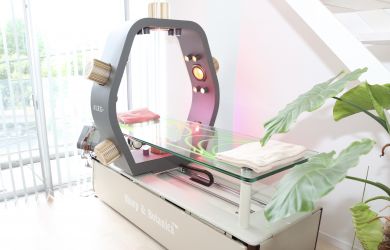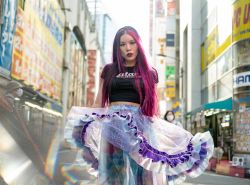
February 16, 2012
The Unforgettable Fire
Photographer Paule Saviano finds a light that shines in the eyes of survivors
By Metropolis
Originally published on metropolis.co.jp on February 2012

Look at the faces below and ask yourself what you see. The unremarkable visages of several old people, perhaps. But look closer—at the way the light, for instance, falls beatifically on the face of Senji Yamaguchi or the faraway look and tightly clasped hands of Sachiko Matsuo—and you will discern touches of deep emotion, for the people gathered here have a reason to feel emotional.
They are all subjects of photographer Paule Saviano’s [pictured] latest book From Above, part of an ongoing project to pay tribute and give voice to those who survived some of most heartrending atrocities of the 20th century. These people, unremarkable as they may seem at first glance, are survivors of the two atomic bombs dropped on Japan as well as the horrific firebombing inflicted on Tokyo. They are witnesses of unspeakable horrors and grim personal tragedy.
The man behind this project might seem an unlikely choice. In the past, Saviano has photographed rock stars and fashion models, while the major project preceding this one focused on strippers and burlesque dancers. So, what motivated the New York lensman to switch to a subject matter that is the polar opposite?

From Above
- ¥8,000, Contents Factory, 256pp.
- Available from Kinokuniya, Amazon.co.jp and www.c-fac.jp
- See more of the book at: http://meturl.com/fromabove
- See Paule Saviano’s photography at:
www.paulepictures.com
“I started photographing this project because I wanted to learn,” Saviano tells Metropolis from Coventry, UK, where he is adding to his catalogue of bombing survivors by photographing those who experienced the German Blitz of 1940-41. “I wanted to hear from people who experienced what happened and how one can overcome a horrific tragedy. I’m covering war from the human side, not promoting sensationalism or politics. I approached the portraits as photographing the human spirit. Their stories of enduring a tragic experience will demonstrate the human spirit can prevail.”
Starting as a relatively small project in 2008, it soon began to snowball as Saviano exhibited his pictures and word got around among survivors that he was someone deeply interested in their plight and a person they could trust.
In Japan, survivors of the atomic bombings are called hibakusha, a term meaning “atom bomb-affected people.” In the past, they have suffered discrimination due to their health and occasional mental problems, as well as from misunderstandings about the aftereffects of exposure to radiation. The stigma of being victims makes many of them wary of people they don’t know, but Saviano was able to win their trust not so much with his lens as with his ears, simply by listening to each one he encountered.
“I think listening is the most respectful action you can give to someone,” Saviano explains. “Maybe my requesting to hear their stories before photographing them demonstrated how much I cared—not only about the photos, but about them. I’m truly interested and concerned about the person in front of my camera. Listening to the stories showed me how much the atomic bomb left a mark on each person’s life. I wouldn’t have realized this without the conversation. My photographs would have lacked the emotion without my understanding of the person I’m photographing or without their trust. The most interesting portraits bleed with emotion; building trust is the only way I can get emotion in my photographs. ”
Itaru Takahara, who survived both the firebombing of Tokyo and the atomic bombing of his hometown Nagasaki—and who later became a photographer himself—describes the process from the point of view of the survivors.
“Before the photo sessions, he listened to our stories for about an hour,” Takahara writes in the book’s introduction. “He came close to our hearts and accompanied our sorrowful memories. When I talked about the sadness of parting with my uncle who had taught me the techniques of photography, Paule listened attentively to my story as if he was one of my family. And through this conversation, all the survivors entrusted everything to Paule and stood in front of his camera peacefully.”
But aren’t the horrors of WWII already documented enough? Any sensible person can surely imagine the horrors of war and the insanity of using nuclear weapons and mass bombing civilian populations. Why does Saviano think it is so important to give voice and picture to the witnesses of these cataclysmic events?
“This is our last chance to listen to this generation of hibakusha,” Saviano comments. “In the near future they will pass away and their voices will be silent forever. We can’t miss this final opportunity. I want people to realize that their voice can make a difference. The choice to use nuclear weapons is made by humans. We can help eliminate the existence of nuclear weapons if we demand. Each voice we can add to this cause makes the greater voice louder.”
Sachiko Matsuo

- b. February 16, 1934
- Nagasaki A-bomb
“On August 8, Nagasaki will turn into ashes,” Matsuo recalls, from fliers dropped by a B-29 bomber. Believing the words, her father built a small hut in the mountains surrounding the city for the family to evacuate to, but this was only 1.3km from the bomb’s hypocenter. When the blast happened, Matsuo was knocked unconscious. When she regained consciousness, she was on the ground barefoot and the sky was as dark as night. The hut had toppled and she only heard her mother’s voice. Her father, two aunts, two elder brothers, and one elder sister all died in the blast or soon after. She still lives in Nagasaki and often speaks about her experiences.
Akihiro Takahashi

- b. July 26, 1931
- Hiroshima A-bomb
A 14-year-old boy when the atomic bomb was dropped on Hiroshima, Takahashi was standing in a schoolyard 1.4km from the hypocenter along with 150 other students. After surviving, he became a prominent peace activist. “Among humankind’s abilities, it is said imagination is the weakest and forgetfulness the strongest,” he wrote in a testimonial. “We cannot, by any means, forget Hiroshima, and we cannot lose the ability to abolish war, abolish nuclear weapons, and imagine a world of peace. Hiroshima is not just a historical fact. It is a warning and lesson for the future. We must overcome the pain, sorrow, and hatred of the past. We must conquer the logic that the dropping of the atomic bomb was justifiable.”
Keiji Nakazawa

- b. March 14, 1939
- Hiroshima A-bomb
Nakazawa was just six years old when the atomic bomb was dropped on Hiroshima. He was 1.2km from the hypocenter. At the time he was meeting a friend, standing behind a wall, which saved him from the intense heat rays. His father, sister and brother all perished. After the war, he became a manga artist, detailing his experiences in the autobiographical Barefoot Gen comic series. “I think young people still do not know much about the atomic bomb,” he told Saviano. “I want to give more information to children to help them learn the reality of war and nuclear weapons through manga, which is easy to approach. I hope the next generation hates war. I want them to learn the importance of peace.”
Yoshiko Hashimoto
- b. May 30, 1921
- Tokyo firebombing

During a firebombing raid on Tokyo in 1945, Hashimoto and her family were forced to flee from their bomb shelter by the firestorm caused by incendiary bombs. She carried her one-year-old son wrapped in a cloth tightly attached to her back. The family fled towards a train overpass for shelter, but it quickly became overcrowded as the fire intensified. They then headed towards a nearby river, during which her younger sister Etsuko was crushed in the stampede. All around flames raged, buildings crumbled, and people’s clothing and hair caught fire from the millions of sparks flying through the air. Her baby screamed. When she looked at him she saw his mouth glowing. He was choking on a burning piece of charcoal that had got stuck in his throat. Hashimoto dug it out with her finger. “I can still see the glowing flames with my eyes closed,” she recalls. She survived the flames by finally jumping into the river.
Senji Yamaguchi

- b. 1930
- Nagasaki A-bomb
Yamaguchi was digging a bomb shelter at a factory 1.4km from the hypocenter of the explosion when the blast struck. He suffered severe burns on his face and body. In 1954, he decided to confront members of the Diet (Japanese parliament) about the conditions faced by atomic bomb survivors. In 1955, he established the Association of Youth of the Atomic Bomb, and has campaigned tirelessly for the abolition of nuclear weapons. In 1982 he attended a UN Special Session on Disarmament, showing a photograph of his scars. “Please look at my face and hands,” he appealed to the delegates. “Please look at them carefully. No people on earth, neither the people who are born in the future nor our children, should have to suffer the death and cruelty of the atomic bomb as we hibakusha did. Please, let us be the last ones to suffer the cruelty.”
Sumiteru Taniguchi
- b. January 26, 1929
- Nagasaki A-bomb

A 16-year-old working as postman at the time, Taniguchi was thrown off his bicycle by the blast. “When I looked up, the house I just passed was destroyed,” he remembers. “The small children who had been playing nearby had been blown away like dust.” His first reaction was to try to pick up the letters he was delivering, but then he noticed that the skin from his left arm was hanging like a flimsy rag and the shirt on his back had been burnt off. Becoming weak, he lay down and watched the flames that made the night as bright as daylight. In the morning everyone around him was dead. Unable to move, he swallowed rain water and barely kept himself alive. When he was hospitalized, burns on his back meant that he had to lie on his stomach for 21 consecutive months. He is now chairperson of the Nagasaki Atomic Bomb Survivors Council.





